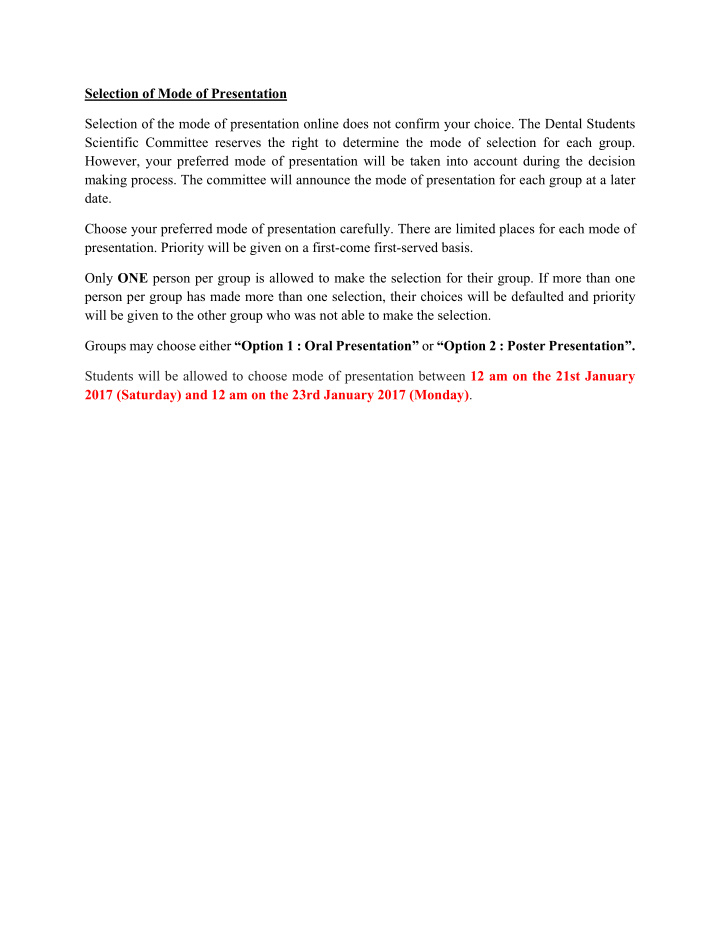



Selection of Mode of Presentation Selection of the mode of presentation online does not confirm your choice. The Dental Students Scientific Committee reserves the right to determine the mode of selection for each group. However, your preferred mode of presentation will be taken into account during the decision making process. The committee will announce the mode of presentation for each group at a later date. Choose your preferred mode of presentation carefully. There are limited places for each mode of presentation. Priority will be given on a first-come first-served basis. Only ONE person per group is allowed to make the selection for their group. If more than one person per group has made more than one selection, their choices will be defaulted and priority will be given to the other group who was not able to make the selection. Groups may choose either “Option 1 : Oral Presentation” or “Option 2 : Poster Presentation”. Students will be allowed to choose mode of presentation between 12 am on the 21st January 2017 (Saturday) and 12 am on the 23rd January 2017 (Monday) .
Abstract Submission Guidelines Students should submit an online copy of the abstract using Word document when choosing the mode of presentation. Please ensure that your supervisor has approved your abstract prior to submission. The Committee will inform if you are required to amend the abstract and you MUST submit the corrected version by the 15 th February 2017. Format of abstract to be submitted (Example given below) Use : Times New Roman font (size 12). Total word count should not exceed 250 words . 1. Title of the project : Bold the title 2. Authors : List each author’s name with surname followed by first and middle initials. 3. Please include the affiliated department of the authors. Content of the abstract a. Objectives : The content of abstract must contain a brief statement of the objectives of the investigation. b. Methods: The content of the abstract must also contain a brief description of the experimental methods used. c. Results : Essential results including data and, where appropriate, statistics should be clearly stated in the abstract content. d. Conclusions : Should not be underlined. e. 4-6 Keywords
Example : Influence of Light and Laser Activated Tooth Bleaching on Enamel Microhardness and Surface Roughness Mohd Yusof E 1 , Abdullah SA 1 , Mohamed NH 2 1. Faculty of Dentistry, University of Malaya, Kuala Lumpur 2. Department of General Dental Practice, Faculty of Dentistry, University of Malaya, Kuala Lumpur Objectives : To evaluate the effects of tooth bleaching on enamel microhardness and surface roughness upon application of hydrogen peroxide activated by light (Beyond TM ) and (LaserSmile TM ) at day 2, day 7 and day 28. Methods : 25 enamel slabs embedded in epoxy resin was prepared. The enamel surface was polished using 1200-grit silicon carbide paper. The specimens were the dividedinto three treatment groups; control (5 slabs), light-activated (10 slabs) and laser –activated (10 slabs) and store in distilled water at 37 0 C. Baseline data was collected for microhardness and surface roughness. For Light-activated bleaching, after application of 25% hydrogen peroxide gel, the specimen surface was activated with light (Beyond TM ) for 10 minutes. Reapplication of gel is repeated for another cycle. For laser- activated (LaserSmile TM ) bleaching, the hydrogen peroxide was activated with laser; 8 cycle for 10 seconds each cycle. Vickers microhardness testing machine was used to determine changes in enamel microhardness after tooth bleaching. Surface roughness was evaluated using surface texture analyzer. Changes in enamel microhardness and surface roughness were evaluated on day 7 and 28 after the bleaching treatment for both intervals. Results : The effects of hydrogen peroxide bleaching on enamel surface microhardness were not statistically significant between the specimens groups of different time intervals except for light. Light activated bleaching does cause microhardness reduction. Conclusion : There were statistically significant differences in surface roughness in laser and light groups. The readings show that bleaching does cause surface roughness alterations of different time intervals. Keywords: tooth bleaching, enamel hardness, enamel roughness, laser-activated
Recommend
More recommend